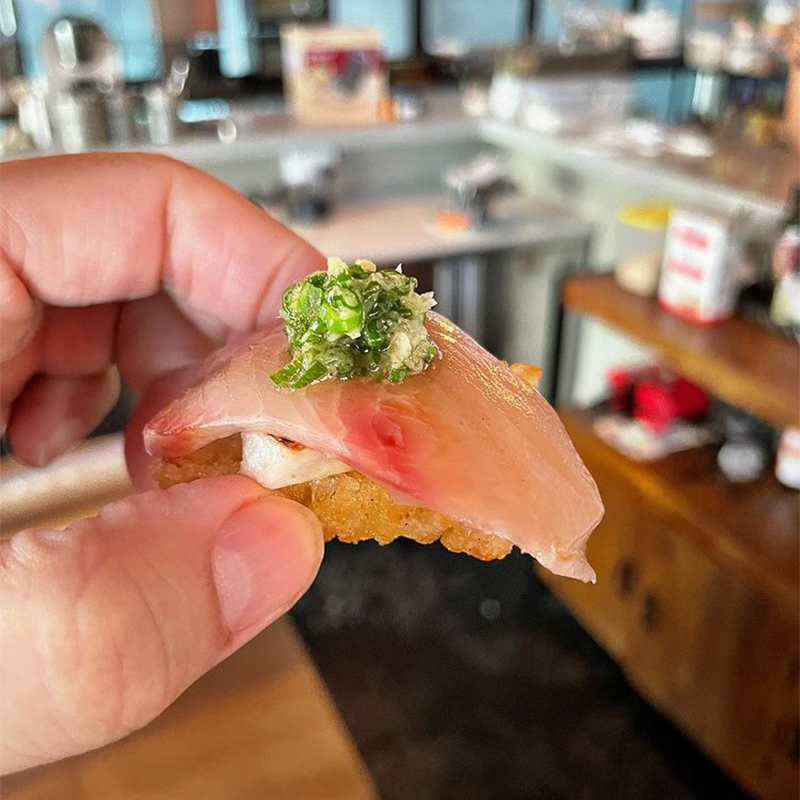“I’m attracted to trying things that don’t exist,” states Bjorn Shen plainly, when asked about his latest and possibly most controversial menu yet at Small’s. Bread sushi—a term that might trigger fury and suspicion in desecrating the hallowed Japanese food staple. “I haven’t had any Japanese people come through yet—I’m not sure if I want them to,” Shen laughs with a hint of wariness.
His concerns are validated. Even for Singapore, home to a myriad of cuisines—where experimentation and fusion is still very much fair game—the idea of bread sushi does sound all too blasphemous for our local palates. But there’s always the burning question of: “What if?”
What Small’s is bested for, falls onto the humble bread. After all, the omakase brainchild of Shen started out with pizza in the picture, before evolving into a bigger 12-seater den for rotating menus, or what he calls “a room of bad ideas”. Now two years in, the MasterChef Singapore judge looked towards a food item that hasn’t been boldly conceived yet. He remarks: “It’s never easy going where no one’s gone before. You can’t Google search for ideas. Oftentimes, there are no existing references.”
Naturally, Small’s dough-making know-how served as a good base: yielded from high hydration, long-aged doughs with the variation of high and low temperature baking, binchotan treatment, deep frying and even steaming. While it still sounds like an influx of carbs, the bread sushi menu is marginally much doable to finish, compared to the pizza courses. Naturally from its sheer difference in size.

To start, your senses get jostled awake with the snack here: baby peas slathered in housemade wasabi dressing. Think of it as a cleanse, as the wasabi does lay on quite the impact. The next few courses follow shortly—from striped jack to hamachi, to tartare made from otoro (fatty tuna). With each fish or seafood accompanying the dough, there’s plenty of thought behind its accompaniments—which happens to be the most critical part of the bread sushi’s success. Take the striped jack for example: it’s plated with Spanish grated tomato and a ginger-scallion relish to enhance and liven up the entire bite. As for the fatty tuna, Shen chooses a housemade bulgogi dressing as well as delicate strips of nashi pear to cut through the richness of the dish.

Most of them turned out to be instant hits, while a particular riff on the Californian Maki roll, didn’t quite make the cut. The iteration was served in a cone of deep-fried dough, where its thickness alongside the seaweed mayonnaise gave the bite extreme density. And it was the only time where we felt the void of sushi rice.
Just like any other omakase meal, the pace and choice of dishes are chosen wisely. Between bites of bread sushi, there was a cold “broth” dish with raw angel prawns, Spanish croutons toasted in prawn oil and doused in a piquant soup made with housemade almond milk, dashi, grape juice and olive oil. The influences enclosed in some of the dishes are a result of Shen’s arsenal of chefs—of Cambodian and Mauritian backgrounds. As you plough through the courses, the intensity and richness levels up. We are talking the wackiest combinations—flounder fin paired with green papaya strips stewed in lime juice, fish sauce and sugar, before it’s showered with grated monkish liver. And it’s whole lot of fun: as you finally reach the end—there’s heat enveloped in a Mauritian version of a vindaloo. Spread on a naked neopolitan pizza, the curry met pumpkin cream, a house-pickled baby cuttlefish and shallots—summing up the finale of the bread sushi bites.

To end off, just like every Japanese omakase meal—Shen serves a dashi-based broth, with mushrooms, playfully-shaped daikons, and Parmesan cheese and bread dumplings. It’s evidently rich, but thankfully, dessert comes bite-sized as well. Atop a cracker, a 20-year-old Kirin bread ice cream laden with fresh shavings of winter truffle. And oddly enough, the savoury-sweet combination sums up the experience nicely.
Our final verdict to unbelievers? Don’t knock it till you try it.





